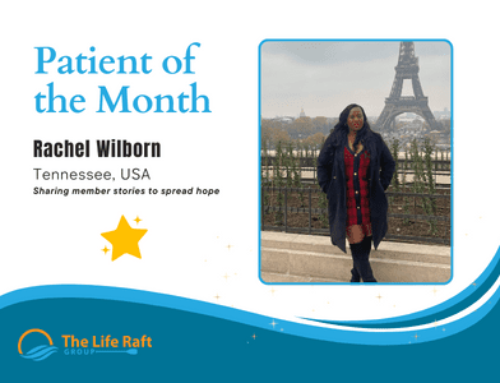Novartis CEO Dr. Daniel Vasella made the commitment in Boston after hearing a plea from Life Raft Executive Director Norman Scherzer. The $2 million grant is the largest single donation for GIST cancer research in history.
Scherzer made his pitch over breakfast with Vasella and David Epstein, president of Novartis Oncology. Scherzer noted that despite the responses to tyrosine kinase inhibition, this therapy often fails, even in patients who had spectacular initial response to Gleevec. Scherzer noted this outcome is not surprising, as single-agent therapy has never controlled widely-metastatic solid tumors.
Because treatment of metastatic or unresectable GIST rarely, if ever, induces complete remission, most GIST will eventually develop resistance mechanisms in the residual tumor cells. That’s why funding is urgently needed to develop research programs to find targeted therapies to counteract GIST treatment resistance.
UNIQUE RESEARCH PARADIGM PLANNED
In response, Vasella agreed to provide the Life Raft Group with $2 million to develop a unique research plan and carry it out. Instead of researchers pursuing individual interests, often with minimal or no coordination with their peers, the Life Raft will recruit experts who’ll draft a research plan to identify and overcome the mechanisms of GIST resistance.
The experts will be asked to identify key research components, including specific timetables, mechanisms for evaluation, and communications and coordination to include shared databases and publications. The experts will be asked to share data on an ongoing basis and agree to maximum collaboration and coordination.
Once this strategic plan is created, the Life Raft Group will seek proposals to carry out the plan’s components, and fund the most promising.
“The hope is to create a new, proactive and coordinated research paradigm that will attract other research dollars looking for a faster and more effective way to achieve scientific breakthroughs,” Scherzer said. “We are running out of time and we must think smarter about how to leverage limited resources to achieve major discoveries.”
RESEARCH OBJECTIVES and PRIORITIES
The overall goal is to find combinations of therapies that benefit GIST patients. While the focus is GIST, the studies should provide insights in developing strategies for other types of metastatic solid tumors. Importantly, these studies will provide the biological rationale to guide clinical evaluations of multi-agent targeted therapies. Researchers will see if there are advantages in attacking multiple targets simultaneously, whether this better kills the tumor and if it stops relapse.
Three main priorities have been identified:
Synergestic Drug Targets —
Determine the critical signaling pathways that are activated when GIST progression begins during therapy. Expression and activation of receptor tyrosine kinase proteins, and crucial signaling intermediates, will be compared in GIST biopsies taken before therapy, and at time of GIST progression/relapse while the patients are still receiving treatment. These analyses will be performed using cDNA profiling and phosphoproteome methods, which have been extensively validated in GIST models.
Preclinical validation of synergistic therapies —
Do preclinical GIST cell line and mouse model studies to determine which combinations of targeted therapies show particular promise. These evaluations will be performed in primary and immortalized treatment-resistant GIST cultures, in non-GIST cell lines (Ba/F3 and NIH3T3) transformed by treatment resistant kinase oncogene constructs, and in transgenic mice that develop GISTs. The laboratory identification and validation of synergistic therapeutic targets will drive the clinical translation of this work, leading to evidence-based algorithms for management of treatment-resistant GIST patients.
Pediatric GIST —
Ten percent of funds will be prioritized to determine mechanisms of treatment resistance in pediatric GIST. Clinical responses to treatment are uncommon in pediatric GIST, where the biology of the disease is different — and often more indolent — than in adults. Yet several studies have shown that pediatric GISTs nonetheless feature strong expression of activated KIT proteins and it is likely that combination therapies involving novel drugs will ultimately prevail in this underserved group of GIST patients.
The studies will be useful in defining the scope, and limitations, of targeted therapies in GIST in particular and metastatic solid tumors in general. Such insights are essential for progress in targeted therapies, and will likely reveal that combinations of such therapies are needed to consolidate initial remissions, and to forestall the emergence of clinical resistance.





